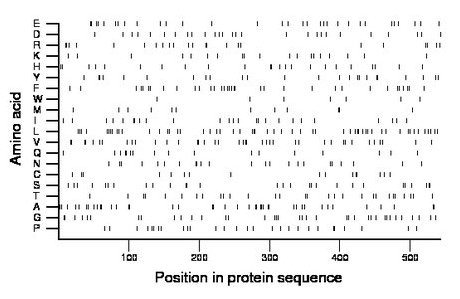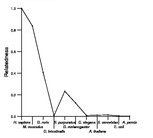
| Name: BTD | Sequence: fasta or formatted (543aa) | NCBI GI: 4557373 | |
|
Description: biotinidase precursor
|
Referenced in: Vitamin Pathways, Coenzymes, and 1-Carbon Metabolism
| ||
|
Composition:

Amino acid Percentage Count Longest homopolymer A alanine 7.6 41 2 C cysteine 2.9 16 2 D aspartate 5.0 27 1 E glutamate 5.7 31 2 F phenylalanine 6.3 34 2 G glycine 7.0 38 2 H histidine 4.4 24 2 I isoleucine 4.8 26 2 K lysine 3.5 19 1 L leucine 9.9 54 2 M methionine 2.4 13 2 N asparagine 4.4 24 2 P proline 5.2 28 2 Q glutamine 3.1 17 2 R arginine 4.2 23 2 S serine 5.2 28 2 T threonine 5.3 29 1 V valine 7.4 40 2 W tryptophan 1.3 7 1 Y tyrosine 4.4 24 2 |
Comparative genomics:
Search single species RefSeq proteins at NCBI
Search summary 
Figure data | ||
Related human proteins:Protein Relative score Description Self-match 1.000 biotinidase precursor VNN1 0.325 vanin 1 precursor VNN2 0.301 vanin 2 isoform 1 precursor VNN2 0.282 vanin 2 isoform 2 VNN3 0.176 vanin 3 isoform 1 precursor VNN3 0.060 vanin 3 isoform 3 precursor VNN3 0.060 vanin 3 isoform 2 precursor NIT2 0.015 nitrilase family, member 2 KDM3A 0.007 jumonji domain containing 1A KDM3A 0.007 jumonji domain containing 1A DDX60L 0.005 DEAD (Asp-Glu-Ala-Asp) box polypeptide 60-like [Hom... GIT2 0.005 G protein-coupled receptor kinase interacting ArfGA... GIT2 0.005 G protein-coupled receptor kinase interacting ArfGAP... GIT2 0.005 G protein-coupled receptor kinase interacting ArfGAP... GIT2 0.005 G protein-coupled receptor kinase interacting ArfGAP... GIT2 0.005 G protein-coupled receptor kinase interacting ArfGA... SLC9A6 0.005 solute carrier family 9 (sodium/hydrogen exchanger), ... SLC9A6 0.005 solute carrier family 9 (sodium/hydrogen exchanger)... UPB1 0.005 beta-ureidopropionase GIT2 0.004 G protein-coupled receptor kinase interacting ArfGA...Human BLASTP results (used to prepare the table) | |||
Gene descriptions are from NCBI RefSeq. Search results were obtained with NCBI BLAST and RefSeq entries. When identical proteins are present, the self-match may not be listed first in BLASTP output. In such cases, the table above has been reordered to place it first.
See About the Figures for the scoring system used in the figure above right. The same scoring system was used in the table of BLASTP results.
Guide to the Human Genome
Copyright © 2010 by Stewart Scherer. All rights reserved.
